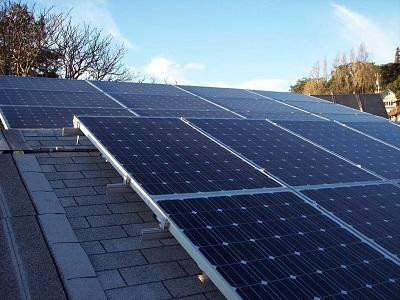PV systems harness the sun's energy using solar cells that convert sunlight into electricity. These cells are grouped together in modules or panels, and mounted on the roof or ground.
Unlike fossil fuels, solar energy is a renewable resource that will never run out. You can receive income from your PV system through feed-in tariffs if it is connected to the grid and used at appropriate times of day.
Solar Panels
A solar PV system is essentially a set of panels that convert sunlight into electricity. When a solar panel is receiving full sunlight, it can generate a large amount of power. If the system is grid-tied, the excess energy produced during peak daylight hours can be sold back to the utility.
Each solar cell converts the Sun’s photon energy into direct current (DC) electricity by knocking electrons loose from atoms. The cells are connected in series to increase the voltage and are encapsulated into a long-lasting unit called a PV module.
There are three main types of PV modules: monocrystalline, polycrystalline and thinfilm. The most efficient and longest-lasting are the monocrystalline panels, which are made from a single piece of pure silicon. Thin-film modules are sprayed or deposited on glass or metal surfaces and have lower efficiencies but are cheaper to manufacture. Builders can make a home “solar ready” during construction, which can lead to substantial savings in installation costs.
Inverters
Inverters convert DC current from solar panels into the kind of AC power we use for household appliances. They also monitor the performance of your solar array and signal any issues or problems with the power grid to which it's connected.
Inverter types include string, multistring and central inverters. The multistring and central inverter options allow multiple solar panels to be connected in a single DC circuit, and they are able to track and control the MPP of each individual panel. This helps with maximizing energy production, especially if some of the panels are shaded or differently oriented.
Microinverters, on the other hand, can be installed directly on, or built-in, each solar panel in your array. They can offer more efficient performance, and they can increase your yield by as much as 5% when shading and panel degradation are taken into account. They can also manage energy storage and energy usage, turning your home into a smart energy home that's less reliant on the electric grid.
Batteries
Batteries are the heart of a solar battery storage system, and they come in several types to suit specific applications. For backup purposes, lithium batteries are best because they’re low maintenance and have a long lifespan. They also offer high efficiencies and quick discharge. Other options for backup batteries are lead acid and nickel cadmium.
Solar batteries accumulate the excess energy generated by your solar panels during the day and use it at night or in low light conditions when the sun is not out. They can also help avoid grid electricity purchases in areas with time-varying utility rates like demand charges.
Battery capacity is rated in kilowatt-hours (kWh). A battery’s round-trip efficiency determines how much power it can deliver to your home and how quickly it will be refilled from the grid. Battery technologies also vary by their cycle life, with shallow cycle automotive batteries compared to deep-cycle solar batteries. Deep-cycle batteries have a longer lifespan and offer a higher energy density than shallow-cycle batteries.
Installation
Once all paperwork is completed, the equipment order can be placed through your installer’s primary distributor. This will occur before the contract is signed that details the total costs.
Photovoltaic system require the installation of a number of electrical components, including combiners, disconnects, circuit breakers and electric meters. These are often referred to as the balance of system (BOS).
Solar panels need to be installed at optimum angles to maximize their physical and economic performance. These optimum angles can be determined using commercial software.
Shade can greatly reduce a solar array’s energy production. Fortunately, PV modules are equipped with bypass diodes that eliminate the loss caused by shading.
It is important that all workers follow standard safety protocols while installing a solar system. This includes wearing proper personal protective equipment, securing ladders and using fall suppression and other safe work practices. It is also a good idea to stop working if rain begins to fall, since this can increase the risk of shock or electrocution.

